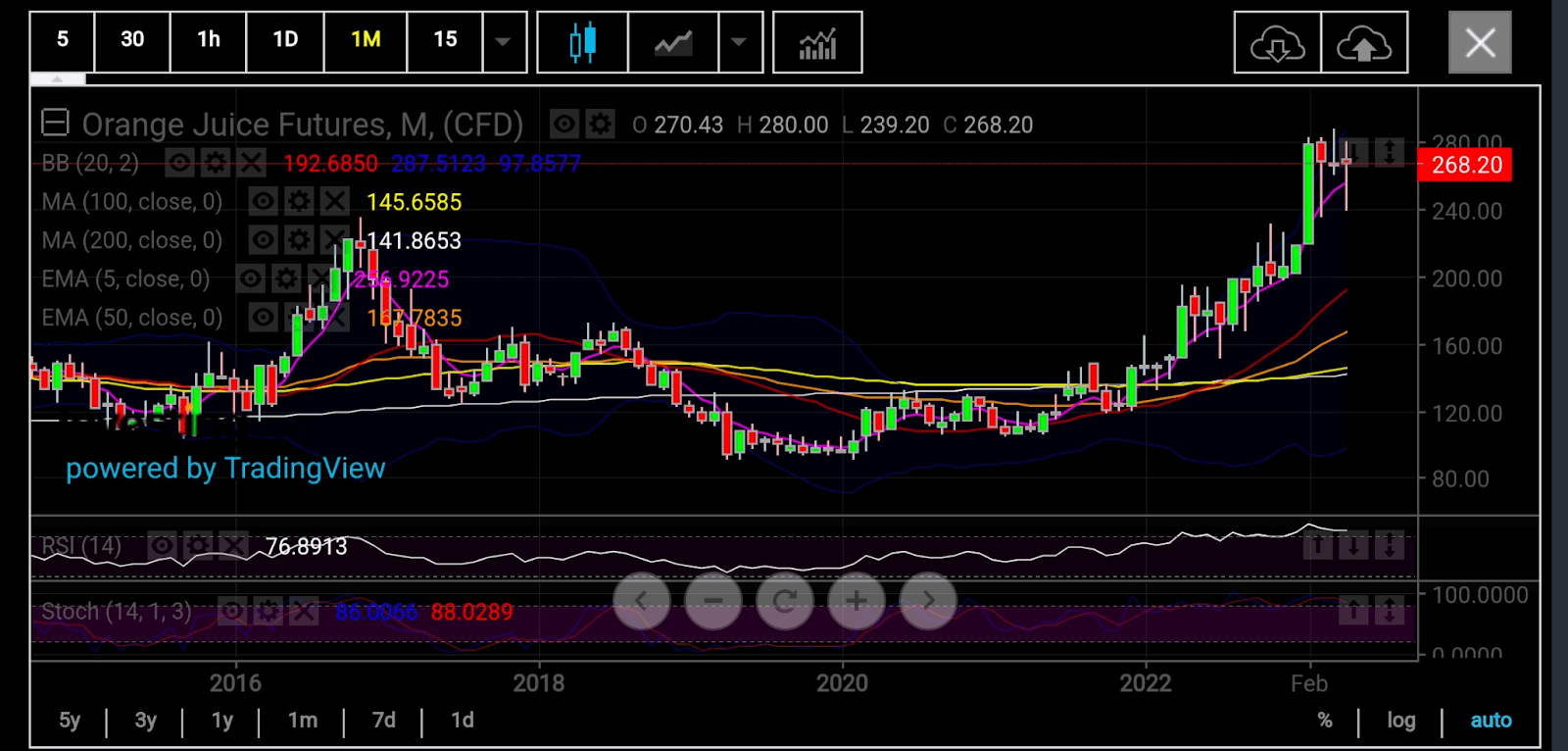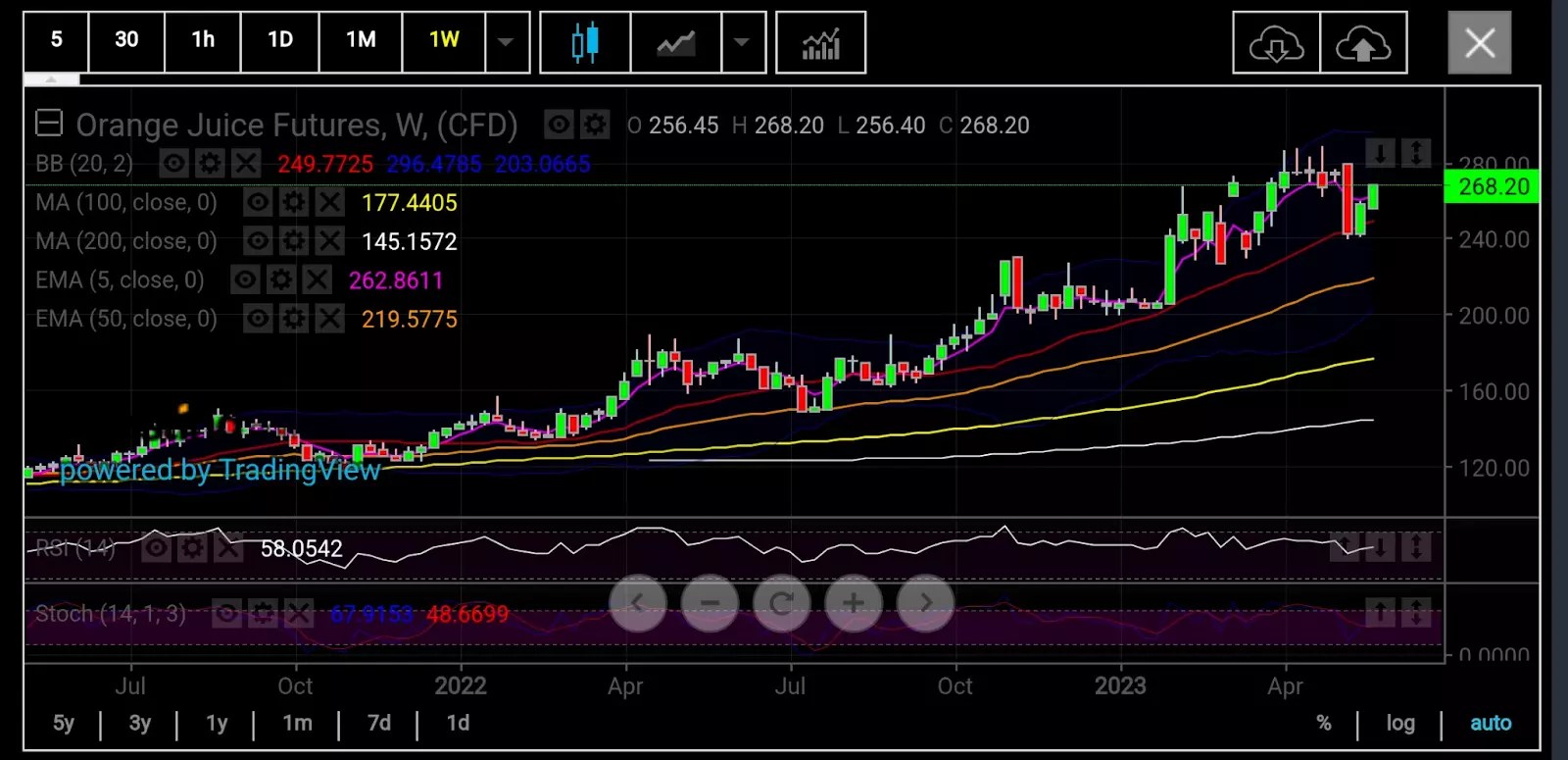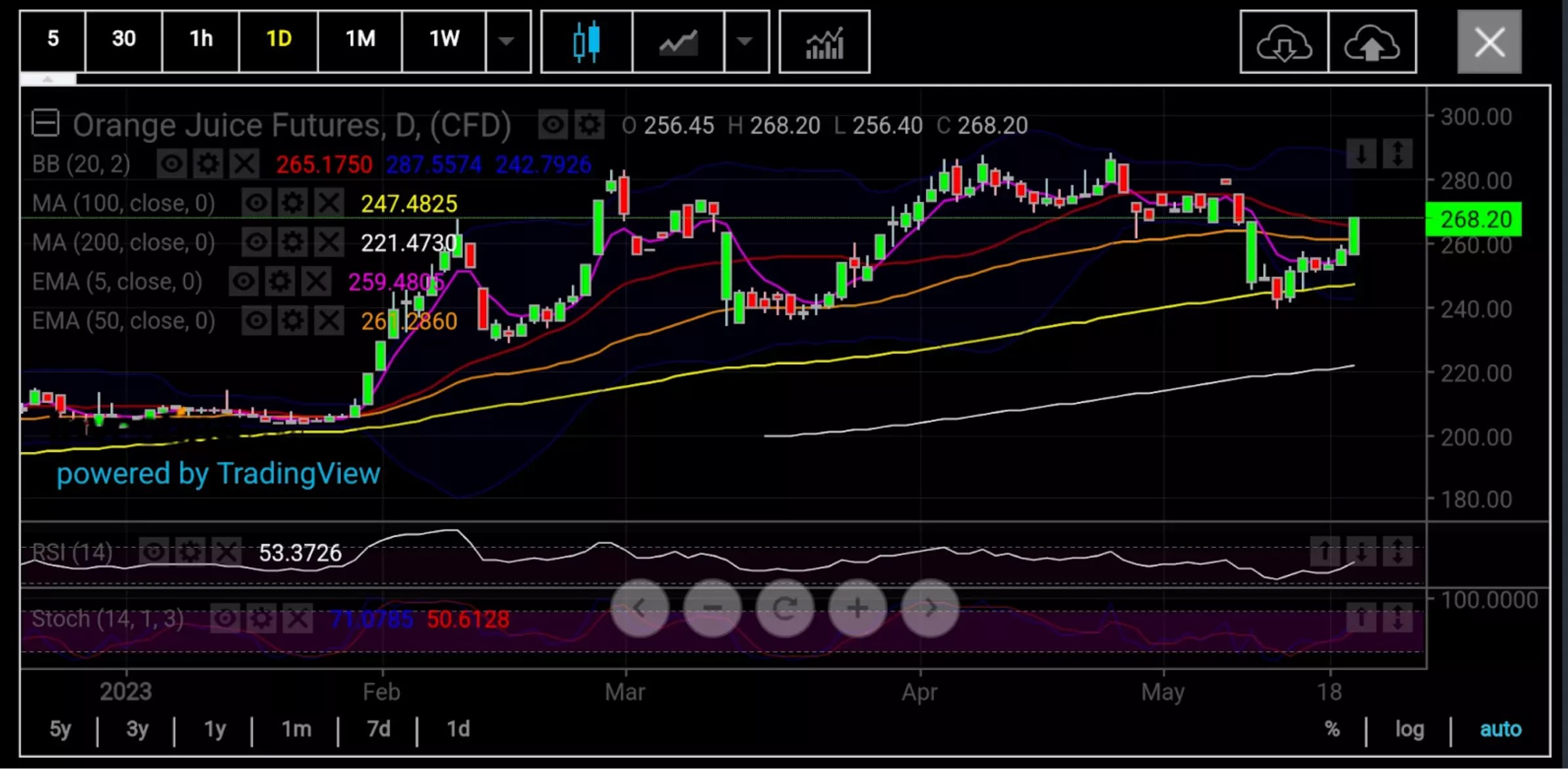OJ
+9.80%
Add to/Remove from Watchlist
Add to Watchlist
Add Position
Position added successfully to:
Please name your holdings portfolio
Type:
BUY
SELL
Date:
Amount:
Price
Point Value:
Leverage:
1:1
1:10
1:25
1:50
1:100
1:200
1:400
1:500
1:1000
Commission:
Create New Watchlist
Create
Create a new holdings portfolio
Add
Create
+ Add another position
Close
FCOJ entrenches position in club of double-digit commodity annual gainers
Orange juice up 29% on the year, could finish May in the black after 2 months of losses
Rabobank says sans overproduction in Brazil, citrus prices look set to stay firm
Charts show bulls could attempt new $3 all-time high that could trigger another price tumble
Away from the rough and tumble of oil, gold and other commodities that may be exposed to the U.S. debt crisis, the exclusive club of raw materials with double-digit gains for the year are pressing ahead with momentum — particularly orange juice which seems to have regained its footing from volatility that followed record highs.
The club of double-digit gainers is all made of up crop commodities: Robusta beans, up 40% on the year; cocoa (+16%); arabica coffee (+13%) and raw sugar, feeder cattle, and frozen concentrated orange juice futures, or FCOJ — which are all up 29% or more each.
 FCOJ Monthly Chart
FCOJ Monthly Chart
Charts by SKCharting.com, with data powered by Investing.com
FCOJ makes an interesting argument, with its front-month appearing to have shaken off bouts of profit-taking that occurred at record highs of almost $2.88 a pound a month back. Case in point: A market that could end May in the positive after losses since February.
And charts indicate that bulls in the space could attempt taking juice to a new all-time high towards $3 before another tumble that could set in.
In Tuesday’s pre-open to its regular New York trading session, FCOJ for July delivery hovered at around $2.68, pulling away from a two-month low of $2.41 hit last week.
The Fundamentals
Jack Scoville, chief crop analyst at Price Futures Group in Chicago, said the bulls in orange juice are trying to turn up the price action on the back of a tight production estimate in Florida, the top U.S. orange growing state. Adds Scoville:
“Demand is thought to be backing away from FCOJ with prices as high as they are currently, but the market has not taken any note and continues to work higher. Historically low estimates of production due in part to the hurricanes and in part to the greening disease that have hurt production, but conditions are significantly better now with scattered showers and moderate temperatures.”
Scoville added that global weather was generally good for citrus production now, including in Florida which has been impacted in a big way by the two storms. Even top citrus grower Brazil has some rain and conditions are rated good, he added.
Scoville’s outlook comes on the back of a recent Rabobank report that’s also positive for FCOJ. According to the Utrecht, Netherlands-based bank the orange juice market is staying tight for at least another season, unless there is a significant supply-side surprise for the 2023/24 harvest in Brazil or a much sharper contraction in global demand in 2H 2023.
Rabobank said record-high orange juice prices in 2023 were a consequence of a very tight market, with smaller-than-expected production and low inventories. However, the decline of OJ demand is set to accelerate this year, in the face of high prices and weaker consumer demand, which will, in part, allow the market to find an equilibrium at high levels. Prices will probably remain high, at least until forecasts for the 2023/24 Brazil harvest provide more clarity on supply relief.
Says Andres Padilla, senior analyst at Rabobank:
“We see very low inventories from two consecutive small harvests in 2020/21 and 2021/22, plus worsening news for the current 2022/23 season. This created the perfect environment for OJ prices to see a significant rally this year, surpassing levels last seen back in 2017 and climbing toward all-time highs. The global OJ market is under supply stress, and the lack of clarity regarding when inventories will be replenished is increasing the upward pressure on prices. In addition, the ongoing decline of production in Florida has meant that US imports have been rising over the past four years, adding demand for exports from Brazil”.
Rabobank said its base assumption was that the United States will remain primarily dependent on imports in the coming years, as there is no clear path for a sustained recovery in Florida under current conditions. Significant additional investments would be required to increase production, but rising production costs are making new investments in orange groves less attractive.
Despite weakening demand, the global supply/demand balance is on course for another deficit this season, albeit smaller than the past two years, Rabobank said.
“All eyes are on the first forecasts for Brazil’s 2023/24 harvest as a measure of global supply. Some early indications suggest that a crop similar in size to 2022/23 could be in the cards, given rain patterns, flowerings, and tree conditions at this stage of the cycle. However, it is unclear whether such a crop would be sufficient to alleviate inventory issues, even if fruit quality and harvest size were both satisfactory.”
The increasing dependence of the United States on imports, ongoing challenges in Mexico with lower productivity, and the absence of other suppliers mean that Brazilian supply will probably remain tight into 2023/24, Rabobank said, adding:
“A couple of sizable harvests will be needed to rebalance the market to a more neutral position, unless of course global demand falls much faster than expected due to high prices, which is a real risk for the OJ category.”
Technicals
So, what are the technical resistances and support for FCOJ?
 FCOJ Weekly Chart
FCOJ Weekly Chart
A new all-time high towards $3 beckons but that could also lead to serious selling, says Sunil Kumar Dixit, chief technical strategist at SKCharting.com. He adds:
“A weekly close above $2.80 can extend the upward move towards the psychological barrier of $3.00, which urges caution as selling pressure from this zone is a high probability that can trigger a sharp drop to $2.60 and $2.40. Weakness below $2.40 will indicate a selling pressure towards $2.20.”
 FCOJ Daily Chart
FCOJ Daily Chart
For now and towards the end of May, Dixit said the 100-day SMA, or Simple Moving Average, of $2.47 has formed a so-called horizontal support base after FCOJ’s strong consolidation above the zone.
“A sustained break above 50 Day EMA dynamically positioned at $261 adds further strength to current momentum and opens way for the next leg higher that matches swing high of $2.80.”
Try InvestingPro for a Week for Free Now!
***
Disclaimer: The content of this article is purely to educate and inform and does not in any way represent an inducement or recommendation to buy or sell any commodity or its related securities. The author Barani Krishnan does not hold a position in the commodities and securities he writes about. He typically uses a range of views outside his own to bring diversity to his analysis of any market. For neutrality, he sometimes presents contrarian views and market variables.
Source: Investing.com


























